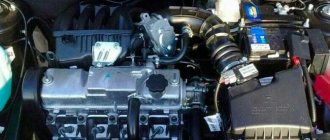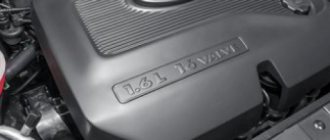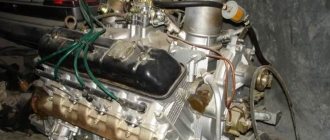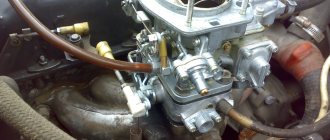"Lada Priora"
"Lada Priora" replaced the 10th series "VAZ". The differences between them are visible to the naked eye. The designers made many changes to both the external and internal design. All changes were first tested on the Lada Kalina, so the Priora turned out to be of very high quality. The first model was presented in 2003, but the car went on mass sale in 2007, when it was finally finalized. Externally, the new Lada resembled something between the old “ten” and Western foreign cars. For example, the rear of the Priora was taken from Opel cars.
Basics of the design and operation of a hydraulic compensator
Configuration
The idea of automatic regulation of thermal clearances can be implemented in two versions: a conventional hydraulic pusher and a hydraulic support. The latter is used in gas distribution modules with rocker arms. On the Lada Priora in the sixteen-valve version, the intake and exhaust are equipped with individual camshafts. The optimal solution for this arrangement is the use of a hydraulic pusher.
The Priorov hydraulic compensator on the 126 engine consists of the following parts:
- A plunger pair, including a cylindrical cage and a piston with a ball valve.
- The outer housing is a pusher.
- System of grooves and holes for oil supply.
Principle of operation
The oil composition enters the internal cavity of the piston and, overcoming the resistance of the spring, pushes the ball away to fill the closed cylinder. When filling the liner, oil pushes the piston out and the hydraulic tappet rests against the cam. Next, the ball valve is locked and the assembly unit works like a regular pusher on motors with an adjustable valve mechanism.
Design
The car is equipped with an airbag, power steering and power windows. The Lada Priora has a high level of safety: the body is made of solid metal, and the airbag is deployed upon impact. Thanks to its low cost and good technical characteristics, the car quickly became popular. Although a little awkward at first glance, the Lada was designed for Russian roads and has many advantages. It has both high ground clearance and a spacious interior. Consumables for a car are relatively inexpensive, so in case of repairs, the car owner will not need to spend his entire fortune on purchasing parts.
Air conditioning systems
One of the consumers is a heating device. It is part of the climate control system. A control controller works with this system. The work is automatic. The driver only sets certain parameters.
On cars, the electrical circuit of a VAZ Priora may contain air conditioning systems. After pressing the button, the relay is activated, the compressor is turned on, power is supplied to the electromagnetic clutch, and the pump is turned on. The air conditioning turbocharger begins to rotate, creating pressure, and begins to regulate refrigerant through the system.
Internal "stuffing"
Compared to the VAZ-2110, the Priora looks much lighter and more mobile. The whole point lies in the completely redesigned bumpers and rear axle of the car, which received a new design. The interior details also received an update. The ground clearance is 165 cm, which is ideal for light off-road conditions and Russian roads. The engineers also took care of savings: fuel consumption per 100 km is only 5-8 liters, depending on the driving mode. The maximum speed of the VAZ-2170 is quite high - 183 km/h. On the highway the car can move at a comfortable speed of 110 km/h. The Priora can accelerate to 100 km in 12 seconds, which is standard for cars in this category.
But the new Lada model is good not only internally. Attention was also paid to the interior of the car, the design of which was developed by a young Italian company. Only high quality materials are used in the manufacture of the machine, there are no gaps between the seams, and overall the model looks very European. The range includes several body options and color schemes, which allows each buyer to choose exactly the option that suits him best. But the main thing in a car is the engine, and it is this that determines its power and character. What can you say about the Lada Priora engine?
Action of auxiliary elements
The list of equipment included in the auxiliary electrical circuit of the VAZ is wider than that discussed above. This:
- light and sound elements, lamps, signal, etc.;
- glass cleaning and washing system;
- interior ventilation unit;
- engine cooling fan;
- rear window heating unit;
- dashboard;
- electric booster;
- electric mirror drives;
- anti-theft system.
For the Priora Lux model, air conditioning, fog lights, light and rain sensors, and several meters of additional wiring will also be added. Before starting, this entire list of equipment will be powered by a battery; after starting, the Priora’s electrical circuit begins to be powered by a generator. When the load is high, some equipment can be switched to battery power for some time. Control over the operation of all wiring and devices is carried out using a set of special sensors.
Engine 8 valves
Lada Priora received several updates during its production. This is logical, because industry does not stand still, and more advanced technologies are constantly appearing in the world. The first models were equipped with an 8-valve engine, which received a lot of criticism. The four-stroke engine is equipped with fuel injection, which allows you to start the car even in sub-zero temperatures. Four cylinders are located on the same line, they correspond to 8 valves. The sedan does not weigh that much, so its ride is light and smooth. Such a car does not need a powerful engine, so the creators of the Priora decided that such an engine would be quite sufficient. The Priora engine (VAZ-2170) with 8 valves has the following characteristics:
- The volume is almost 1.6 liters.
- Crankshaft rotation speed: 860 rpm.
- The maximum speed that the Lada Priora can reach with an 8-valve engine is 160 km/h.
- The piston stroke is 73 mm.
- The maximum engine power is 90 horsepower.
The VAZ-2170 with an 8-valve engine is the most affordable among the series. Overall, this unit is good and budget-friendly and gets the job done. But many drivers were still unhappy with the weak engine, so the automaker soon released a new, improved engine.
Why is adjustment necessary?
The correct procedure depends on:
- uninterrupted operation of the LADA Kalina engine (operation with a reduced noise level in the timing belt, no errors in the camshaft sensor);
- reduction of fuel consumption to a level close to that regulated by the manufacturer;
- less wear on the camshaft cams and the pushers interacting with them.
- cleanliness of combustion chambers and valve plates due to the absence of carbon deposits.
Valve adjustment in a Lada Kalina car should be carried out with a periodic mileage of 20 thousand km or a little more.
It is not recommended to neglect this procedure, since the regulatory value of the gaps at the valves of the intake and exhaust circuits changes. This circumstance provokes a loose fit of the valve discs to the seat seats, which inevitably leads to the formation of carbon deposits, incomplete combustion of fuel, damage to the discs with subsequent burnout and other troubles in the timing belt in the LADA Kalina model. As you can see, in the absence of the required clearances, there is a violation of the correct functioning of the engine as a whole, and the only harmless point here is the owner’s acoustic discomfort due to the increased noise of the timing belt.
Note that adjustment of the valve mechanism requires 8 valve engines of Lada Kalina cars.
16 valve engine
Soon after the launch of Lada Priora production, some cars began to be equipped with 16-valve engines of model 21126. Technically, models with 8 and 16 valves differ quite significantly. The design of the 16-valve engine is different in that in the upper part it has not one shaft, but two. Accordingly, the number of valves is exactly doubled. Four valves per shaft provide greater engine power. Two valves admit fuel, and two release exhaust gas. Thus, much more fuel can flow into the internal combustion engine at the same time. The efficiency of the car increases, it consumes less gasoline, and it takes less time to accelerate. Such results are also achieved because the 16-valve engine has hydraulic compensators that press the valves tightly against the driveshaft.
The Priora engine with 16 valves has another feature - more horsepower. With a volume of 1.6 liters, the engine power can reach 100 horsepower, which certainly has a positive effect on the dynamics of the car. The declared resource is quite small. The manufacturer guarantees the serviceability of the internal combustion engine only for a period of no more than 150 thousand kilometers. But in practice, reviews from motorists indicate that a car can travel 250 thousand without major repairs. Among other characteristics of the new Priora engine, we can note the torque, which reaches 230 nM. The closed liquid cooling system effectively removes heat from the engine and protects the car from overheating in heat up to +50 degrees.
Problems when paying with bank cards
Sometimes difficulties may arise when paying with Visa/MasterCard bank cards. The most common of them:
- There is a restriction on the card for paying for online purchases
- A plastic card is not intended for making payments online.
- The plastic card is not activated for making payments online.
- There are not enough funds on the plastic card.
In order to solve these problems, you need to call or write to the technical support of the bank where you are served. Bank specialists will help you resolve them and make payments.
That's basically it. The entire process of paying for a book in PDF format on car repair on our website takes 1-2 minutes.
If you still have any questions, you can ask them using the feedback form, or write us an email at
Engine Features
The Lada Priora engine is simple and reliable, so it rarely needs repairs. A durable cast-iron cylinder block and the coolant passing between them form the basis of the design. The cylinder head is made of aluminum and contains valves. The engine pistons are also made of aluminum. Their bottom is decorated with special grooves that protect the engine from serious damage in the event of a breakdown or accident. The poly-V-ribbed timing belt is securely fastened and protected from slipping. To do this, the belt is limited on one side by a belt, and on the other by a special washer.
The Priora engine of the 126th series was equipped with completely new pistons, which were developed by Federal Mogul. Their weight is 30% less than that of the VAZ-2110. Each piston has three rings, the surfaces of which are protected by tin coating. All these innovations make it possible to extend the life of parts and reduce the cost of their repair. The cast iron crankshaft has an increased piston stroke - in the new model it is 94 mm. The Priora engine valves are made of heat-resistant material and can be rotated during operation, therefore they have less wear.
List of spare parts and prices: cylinder block
- Pistons. STI company. Piston material is forging. The pistons have grooves for the valves so that if the valve belt breaks, the piston cannot be removed. The point of a forged piston is that it maintains strength while being lightweight and is also resistant to detonation. The compression ratio increases, instead of 11 it will be 11.8. The piston surface is coated with Molycote anti-friction coating.
- We buy standard connecting rods, they are durable and light.
- Mahle piston rings. Many car enthusiasts know about the reliability of this company, so the rings do not need any special introduction.
- We leave the flywheel standard; if desired, you can remove 1 kg from the surface.
- Crankshaft oil seals are from the domestic company BRT, which has been showing its best performance for a long time.
- We also purchase domestic inserts.
Update
The new engine has a number of improvements that have significantly improved its performance. What's new in the series of engines that began production in 2007?
- Increased piston stroke. Thanks to this, the engine capacity was increased from 1.6 to 2.3 liters.
- New intake manifold, which improves performance at low and medium speeds.
- Automatic valve adjustment using hydraulic compensators.
- Upgrading the crankcase ventilation allows you to release less exhaust gases into the atmosphere. And reducing the weight of the piston group means the engine consumes less fuel.
- Most parts are imported.
- The motor has an extended service life of 200 thousand kilometers.
pros
"Lada Priora", without a doubt, captivated many with its characteristics and price. However, its engine has a number of pros and cons, knowing which you can avoid many problems. Among the advantages are the following:
- Reliability. Yes, the Lada engine is far from the BMW, but it copes with the assigned tasks with a bang. Simple and good-quality, it can last up to 200 thousand kilometers, and after major repairs it can last the same amount.
- Cheap consumables. Engine parts can hardly be called cheap by definition, but repairs from Priora will cost much less than cars from foreign manufacturers.
- The power for a lightweight Lada 2170 is quite sufficient to accelerate at a sufficient speed. The 21126 engine with 16 valves can produce power up to 100 horsepower and reach speeds of up to 180 km/h.
- Environmentally friendly. The Priora engine fully complies with European quality standards and emits less exhaust gases into the atmosphere than its predecessors.
- Good traction at both high and low speeds appeared after modification of the exhaust manifold.
- The efficiency of the 16-valve engine is significantly greater than that of previous generations of Lada due to its design. Because of this, the car consumes less fuel.
As you can see, there are many advantages. It is not difficult to understand why the Lada Priora became so popular in Russia. The Russian-made car was created for our roads, and its design took into account all the pitfalls. But not a single thing can be ideal, so disadvantages can also be found in the VAZ-2170.
Minuses
Basically, the disadvantages relate to the 8-valve power unit, which has a lower cost:
- Many drivers do not like the noise that the engine makes at high speeds. Even increasing the sound insulation of the cabin does not save you from it.
- If there is insufficient fuel, the car may simply refuse to start.
- A timing belt break is still the most pressing problem for Priora owners. That is why owners recommend changing the part every 50 thousand kilometers.
- Floating idle speed.
- Frequent failure of the injector throttle valve.
How to eliminate the knocking of hydraulic pushers on Lada Priora
Timely and high-quality maintenance of the engine oil system is the key to flawless operation of the hydraulic compensator mechanism. After all, the unit is designed for use throughout the entire resource of the power plant.
Use of recommended lubricant
When the hydraulic pushers just start knocking, the manufacturer recommends changing the lubricant to a proven option. Therefore, when the question arises of what kind of oil to pour in principle, it is worth analyzing reviews to determine the acceptability of a certain model of oil product for hydraulic compensators.
Of course, the best choice for Lada Priora will be the composition recommended by the manufacturer, specified in the instruction manual. However, not all current popular products are included in the list.
Owner reviews
Which Priora engine should you choose? Reviews from car owners vary. Some advocate 8 valves, considering it simpler and cheaper to repair. Others prefer a 16-valve power unit, which gives the car more power and dynamics. Everyone turns out to be right in their own way. For example, reviews from experts say that when the timing belt breaks, more damage occurs on a 16-valve engine than on an 8-valve engine, and repairs are more expensive. But experienced drivers recommend not waiting for a breakdown and replacing the belt at 50-75 thousand kilometers. Otherwise, buyers speak very positively about the Priora engine. They note good power in both third and fifth speeds, rare breakdowns and high-quality parts. Priora engines are advised to use only high-quality oil, preferably synthetic. It will help extend the life of the machine.
Operating principle of hydraulic compensators
The main purpose of using HA in the Priora engine is to simplify the engine maintenance procedure. If previously it was necessary to adjust each valve separately, now this procedure is carried out automatically.
Structurally, the hydraulic compensator is a cylindrical part, which consists of a plunger pair located inside its body, as well as a check valve.
The operating principle of this mechanism is simple. During operation of the power unit, the camshaft cam presses the bottom of the cylinder. In this case, the hydraulic compensator moves, as a result of which the plunger presses on the valve and, accordingly, it opens.
The clearance mentioned above is regulated by the oil pressure entering the cavity under the plunger. The greater the oil pressure, the stronger it acts on the plunger and, accordingly, the valve opens with a larger gap.











